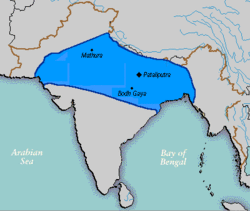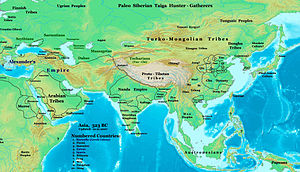Nanda Empire
Nanda Empire | |||||||||
|---|---|---|---|---|---|---|---|---|---|
| 424 BC–321 BC | |||||||||
 The Nanda Empire at its greatest extent under Dhana Nanda circa 323 BC. | |||||||||
| Capital | Pataliputra | ||||||||
| Common languages | Sanskrit | ||||||||
| Religion | Jainism Hinduism Buddhism | ||||||||
| Government | Monarchy | ||||||||
| Samrat | |||||||||
| Historical era | Antiquity | ||||||||
• Established | 424 BC | ||||||||
• Disestablished | 321 BC | ||||||||
| |||||||||
| History of South Asia |
|---|
 |
The Nanda Empire originated from the region of Magadha in ancient India during the 5th and 4th centuries BC. At its greatest extent, the Nanda Empire extended from Bengal in the east, to Punjab in the west and as far south as the Vindhya Range.[1] The Nanda Empire was later conquered by Chandragupta Maurya, who founded the Maurya Empire.
Establishment of the dynasty
Mahapadma Nanda, who has been described as "the destroyer of all the Kshatriyas", defeated the Panchalas, Kasis, Haihayas, Kalingas, Asmakas, Kurus, Maithilas, Surasenas and the Vitihotras; to name a few .[citation needed]. He expanded his territory south of the Deccan plains. Mahapadma Nanda, who died at the age of 88, was the ruler of the Nanda dynasty for all but 12 of the dynasty's 100 years. The Nandas who usurped the throne of the Shishunaga dynasty were thought to be of low origin with some sources stating that the dynasty's founder, Mahapadma, was the son of a Shudra . [2]
Nanda Rule
The Nandas are sometimes described as the first empire builders in the recorded history of India. They inherited the large kingdom of Magadha and wished to extend it to yet more distant frontiers. To this purpose they built up a vast army, consisting of 200,000 infantry, 20,000 cavalry, 2,000 war chariots and 3,000 war elephants (at the lowest estimates).[3] According to Plutarch however, the size of the Nanda army was even larger, numbering 200,000 infantry, 80,000 cavalry, 8,000 war chariots, and 6,000 war elephants. However, the Nandas never had the opportunity to see their army up against Alexander, who invaded India at the time of Dhana Nanda, since Alexander had to confine his campaign to the plains of Punjab, for his forces, frightened by the prospect of facing a formidable foe, mutinied at the Hyphasis River (the modern Beas River) refusing to march any further. This river thus marks the eastern-most extent of Alexander's conquests.

- "As for the Macedonians, their struggle with Porus blunted their courage and stayed their further advance into India. For having had all they could do to repulse an enemy who mustered only twenty thousand infantry and two thousand horse, they violently opposed Alexander when he insisted on crossing the river Ganges also, the width of which, as they learned, was thirty-two furlongs, its depth a hundred fathoms, while its banks on the further side were covered with multitudes of men-at-arms, including horsemen and war elephants. They were told that the kings of the Ganderites and Praesii were awaiting them with eighty thousand horsemen, two hundred thousand footmen, eight thousand chariots, and six thousand fighting elephants.".[4]
The Nandas made the collection of taxes methodical, by regularly appointed officials, a part of their administrative system. The treasury was continually replenished, the wealth of the Nandas being well-known. The Nandas also built canals and carried out irrigation projects. The possibility of an imperial structure based on an essentially agrarian economy began to germinate in the Indian mind.
List of Nanda rulers
- Mahapadma Nanda (c. 424 BC – ?)
- Pandhuka
- Panghupati
- Bhutapala
- Rashtrapala
- Govishanaka
- Dashasidkhaka
- Kaivarta
- Mahendra
- Dhana Nanda (Argames) (? – c. 321 BC)
Footnotes
- ^ Radha Kumud Mookerji, Chandragupta Maurya and His Times, 4th ed. (Delhi: Motilal Banarsidass, 1988 [1966]), 31, 28–33.
- ^ "Nanda Dynasty – MSN Encarta". Archived from the original on 2009-11-01.
{{cite web}}: Unknown parameter|deadurl=ignored (|url-status=suggested) (help) - ^ cf. Diod. XVII.93.2; Curt. IX.2.3–4; Plut. "Alex." 62.3.
- ^ Plut. "Alex." 62.
